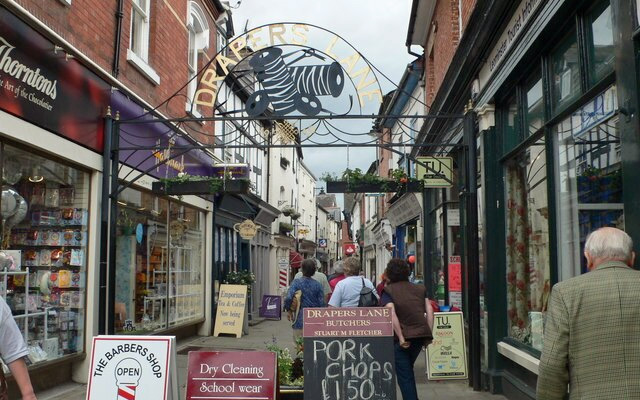Leominster
Leominster (pronounced 'Lemster') is an attractive market town surrounded by rich farm land. During the middle ages it became one of the great English wool markets, trading as such for over 500 years. The local wool, known as Lemster Ore, was renowned for its high quality. Produced from 'Ryeland' sheep and bred by the local Benedictine monks. The monks at that time believed the name Leominster meant 'Monastery of the Lions' but it's more likely derived from the Latin name for marshes.

Drapers Lane © Eirian Evans (CC2)
The town's narrow streets are packed with ancient half-timbered houses, contrasting well with other fine Georgian and mellowed Victorian properties. Drapers Lane, in particular, has several picturesque Tudor properties. It is a pleasant traffic free passage lined with quaint shops and Cafés, with several smaller alleys running off on either side. The High Street has some good medieval structures and Broad Street and Etnam Street many fine 18th-c buildings. Notable pubs include the 16th-c Chequers Inn and The Royal Oak, a solid old market inn.
The magnificent grey-stone Priory Church of St Peter and St Paul has an imposing Norman portal, elaborately carved with mythical birds beasts and serpents. The church has three naves built in the 12th, 13th and 14th centuries respectively. The site was originally a Saxon foundation, donated by Lady Godiva's husband, Earl Leofric. The remainer of the priory buildings disappeared after the Dissolution of the monasteries in 1541.
The original town ducking stool can be seen in the church, which was last used in 1809. These ducking or cucking stools were common place in Britain during the 17th and 18th centuries. Used as a tool of punishment and humiliation for fraudulent tradespeople, drunk and disorderly and nagging wives!
Good trout fishing can be found in the rivers Lugg, Pinsley and Arrow. The countryside south and west of the town is lush farmland, peppered with apple orchards and hop-kilns.
Places of interest to visit in Leominster
One attraction really worth visiting is Grange Court, built in 1633 by John Abel. A finely carved Jacobean masterpiece it is one of the loveliest timber-framed buildings in the country. The court once served as the town hall until mid-Victorian times when it stood at the crossroads in the centre of town. It was moved in the 19th-c to its current preserved location on the lawns of the Grange. Open to the public Monday - Saturday 10am – 4pm.
The Leominster Museum (Etnam Street) specializes in local lore, costumes and agricultural equipment, with displays of local history from pre-Roman times to the present day. Open: Monday to Saturday from 10am – 4pm.
The Black and White Village Trail is a 40 mile circular route, which starts and finishes in Leominster. It takes in many Hereford and Worcester villages, and boast some of the finest black and white architecture in the country.
Standing five miles north-west of the town is the 14th-c Croft Castle (National Trust).
The Iron Age fort on Brierley Hill is one of the most interesting prehistoric camps in Herefordshire.
Map of Leominster
The Midlands

